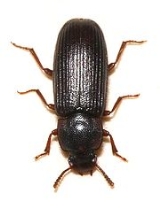
Destructive flour beetle
Encyclopedia
The destructive or dark flour beetle (Tribolium destructor), one of the species of darkling beetle
known generally as flour beetle
s, is a common pest insect known for attacking and infesting stored flour
and grain
.
It is a very dark brown beetle (darker than other Tribolium species) 5–6 mm. long. T. destructor is found in North America
, Europe
and Africa
.
As well as damaging flour and grain, it attacks animal food pellets, rolled oats and poultry food.
Darkling beetle
Darkling beetles are a family of beetles found worldwide, estimated at more than 20,000 species. Many of the beetles have black elytra, leading to their common name...
known generally as flour beetle
Flour beetle
Flour beetles are members of the darkling beetle genus Tribolium or Tenebrio. They are pests of cereal silos and are widely used as laboratory animals, as they are easy to keep. The flour beetles enjoy wheat and other grains and are adapted to survive in very dry environments and can withstand high...
s, is a common pest insect known for attacking and infesting stored flour
Flour
Flour is a powder which is made by grinding cereal grains, other seeds or roots . It is the main ingredient of bread, which is a staple food for many cultures, making the availability of adequate supplies of flour a major economic and political issue at various times throughout history...
and grain
GRAIN
GRAIN is a small international non-profit organisation that works to support small farmers and social movements in their struggles for community-controlled and biodiversity-based food systems. Our support takes the form of independent research and analysis, networking at local, regional and...
.
It is a very dark brown beetle (darker than other Tribolium species) 5–6 mm. long. T. destructor is found in North America
North America
North America is a continent wholly within the Northern Hemisphere and almost wholly within the Western Hemisphere. It is also considered a northern subcontinent of the Americas...
, Europe
Europe
Europe is, by convention, one of the world's seven continents. Comprising the westernmost peninsula of Eurasia, Europe is generally 'divided' from Asia to its east by the watershed divides of the Ural and Caucasus Mountains, the Ural River, the Caspian and Black Seas, and the waterways connecting...
and Africa
Africa
Africa is the world's second largest and second most populous continent, after Asia. At about 30.2 million km² including adjacent islands, it covers 6% of the Earth's total surface area and 20.4% of the total land area...
.
As well as damaging flour and grain, it attacks animal food pellets, rolled oats and poultry food.
External links
- Tribolium species are hard to identify. Here are four species side by side. Note that several species of Tribolium may occur in the same infestation.Colpolon

